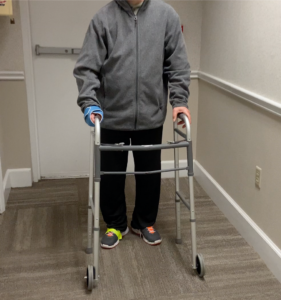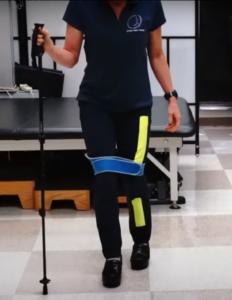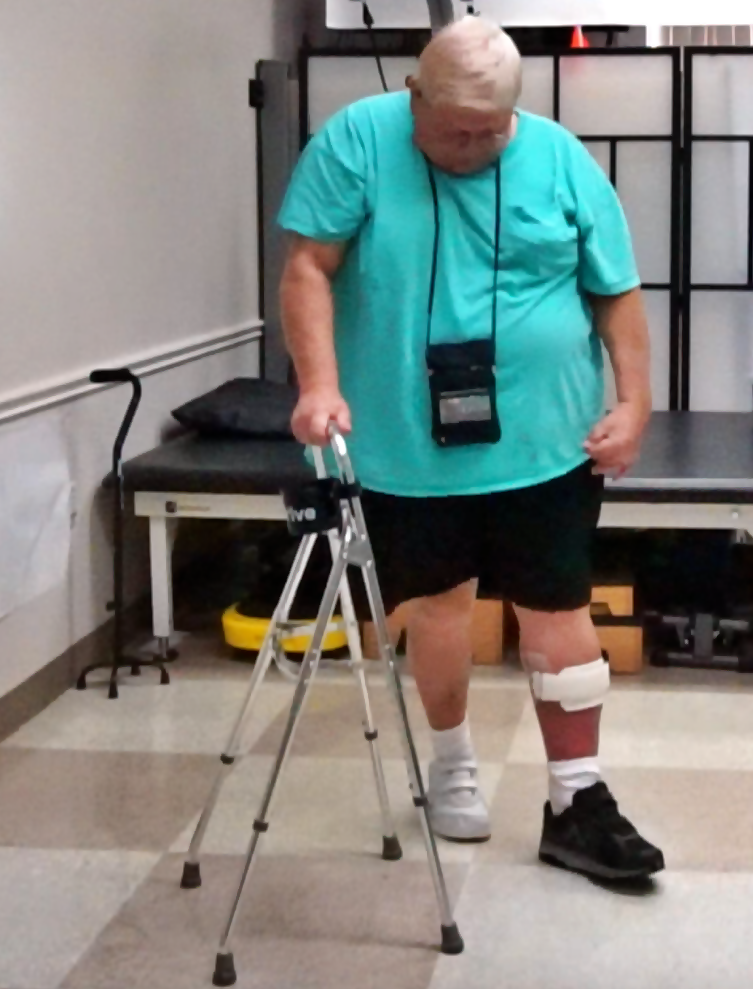Re-learning how to walk after a stroke can be challenging. And finding the best walking aid can be one of the most critical decisions when it comes to regaining your independence. But with so many different options on the market, how do you choose? Well, you are in luck. Here I am going to go over everything I like and don’t like about a few of the most popular devices as well as give some guidance on what “type” of person is best suited to each specific device.
1. U-step Walker
Ok, I am going to jump right into it with, by far, my favorite walker on the market. It is the U-step walker. This walker is undeniably the “cadillac” of walkers for any neurologic diagnosis. But before I dive into what I LOVE about this walker, let me first tell you all the reasons why I dislike the infamous four wheel walker (also known as a rollator).
Things I hate about a four-wheel walker (aka rollator)
Bad hand grip position:
First, I have never seen anyone stand upright when using a four wheel walker. This is due to several reasons. One, the seat is usually in the way and to reach the handles it is near impossible without leaning forward. So, what if you seat flips out of the way? Ok, that will allow you to get in a better position, however, the majority of people STILL lean forward (even with the seat flipped out of the way). And that leads me to the second problem with this walker…….the breaking system.
Horrible Braking System:
When you are walking, the breaks must remain unlocked and this inevitably causes the walker to slowly “drift” away from people as they walk. Once the walker is even slightly out in front, most people do not have the strength in the back and the hip muscles to keep pulling it (the walker) back to the correct position. I mean, think about it. It is kind of counter-intuitive to be pulling a walker backward when you are trying to walk forward. ?Hence, the walker drifting forward, the “driver” leaning forward and begins the dreaded progression of the forward flexed posture. Ugh.
Lightweight design
The third problem with a rollator is the weight. A lightweight walker is good, right? Well, not necessarily. Having a lightweight walker might make it easier to get in and out of a vehicle, however, it also makes the walker less stable. This can become a problem if someone accidentally rolls a wheel off the side of a side as the walker is much more “tippy”. A lightweight walker with a seat also makes it hard to get up and down from the seat.
“Slippery wheels”
And finally, the wheels. Now, I don’t really understand why this is, but four big wheelchair have a tendency to “slip”. The brake tends to slip on the wheel. For some reason, having smaller wheels eliminates this issue (which I will talk more about when we get to the U-step).
So, long story short, I am not a fan of a rollator. Now, that makes the specs I am about to cover on the U-step, even more impressive.
Why is the U-step a Better Walker for Neurologic Conditions?
And why should they not be? This walker was actually designed by someone who had parkinson’s disease. And that is the only explanation I can give for how and why they thought of every detail in how to make this walker the most stable walker on the market.
- Secure braking system: the wheels are smaller and very solid. This wheel design makes it near impossible for the breaks to “slip” once they are engaged.
- Reverse brakes: the reverse braking system is the only one of its kind on the market. The breaks are always engaged unless you squeeze the “brake release”. This makes the walker less likely to roll out in front when walking and makes it much more sturdy if someone were to lose their balance.
- Breaking with one hand: The breaks will release by just squeezing one handle. This makes it perfect for anyone who also has arm/hand weakness on one side (hemiparesis)
- Seat position: the seat position is also unique in that it does not obstruct a normal size step reducing the chances of leaning forward to avoid hitting your legs on the seat when you are taking a step.
- Handle position: Along the same lines as the seat position, the handles are also offset further than most walkers making them easier to grasp without having to lean forward
- Turning radius: the smaller wheel design also makes this walker “turn on a dime” meaning it has a smaller turning radius than a traditional four-wheel walker
- Base position: the wheels in the back are also offset making this walker hard to “tip backward” if someone were to use the walker to pull up from a sitting position.
Things I dislike about the U-step Walker
This walker is on the pricier side. However, if you were to compare the cost of this walker to all the expenses involved in falling. Not to mention the emotional toll a fall would have, it is a no brainer. This walker is worth its weight in gold. Now that leads me to the actual weight of the walker. It is a much heavier walker so getting it in and out of a vehicle can be challenging. Here is the best way to get this heavier walking into a vehicle:
1. Fold the walker
2. Open the trunk
3. Lean it up against the back of the vehicle
4. Slide the walker into the trunk.
This will avoid the issue of having to lift the walker to get it into the trunk.
2. Traditional Walker
Too often, we are all quick to right off the standard 2 wheel walker. Maybe it is because it is one of the cheaper walkers on the market. However, the old term “you get what you pay for” does not apply.

This walker is light-weight and the fact that it only has 2 wheels makes it much more stable than a four-wheel walker. Now about the wheels. Now, I now many think more is better, however, the two wheel design is the brilliance behind this very simple design. This walker is near impossible to “drift” away like the rollator has a tendency to do. This is because as the walker drifts forward, more weight goes on to the back (straight) legs (without wheels) and pushes them into the ground. Because they do not have wheels this results in the walker being unable to roll forward. So not only may it prevent someone from falling forward, it will also decrease the chances of someone getting into that forward flexed position that I mentioned above.
3. Gait Poles/Walking Sticks

Gait poles are the ideal “device” for someone who is trying to progress off of a walker. What I love about gait poles is that they are a little taller. In addition to this, the grip/handle orientation is vertical versus the horizontal orientation of the grip on a cane. This, also, helps to promote a more upright posture.
4. Four Wheel Walker
Ok, now I am not going to beat a dead horse, so I will just say, you know how I feel about this walker. I am going to include it in the list of devices with a link to one that I think is probably the more stable version on the market. But again, this would be my last choice when it comes to a safe and appropriate walker for someone with a neurologic condition.
What most people like about it (my opinion), is the seat. I can’t imagine many people saying that they feel MORE secure with this type of walker over a standard two-wheel walker. First, it has 4 wheels it has a tendency to roll way out in front placing a person in a forward bent posture. No bueno. I have no doubt this is the cause of most low back pain in the elderly population. But once again, I digress. I will compare this to a 2 wheel walker where the back legs/supports do not roll. In this case, when the walker starts to get out in front of someone, more pressure goes to the back (non-rolling) legs. This actually pushes it into the ground and stops it from rolling forward. (who doesn’t LOVE physics ?)
5. Hemi Walker

A hemiwalker is a walker that only requires the use of one hand and, therefore, is meant for someone with hemiplegia. In most cases this causes someone to rely more on the strong side of the body. This has a significant negative impact on stroke recovery. In addition to this, because the support (and sense of security) is on one side, most havee a tendency to lean more to that side. Leaning to the strong side, can make it much harder to re-establish your brain’s ability to identify where your body is in space . We refer to this as midline orientation.
All that being said, the one time I have suggested this type of walker is for someone who has multiple orthopaedic injuries. This can happen if someone falls and injures an arm and a leg. For example, if someone broke their right arm and injured their right knee, the doctor might say that they can’t use the right arm and must use a one handed walking device. A hemiwalker might be appropriate because it provides more support than a standard cane. In this case, the brain’s ability to find center is intact and therefore leaning to one side for 4-5 weeks while bones heal would not be a problem. And in fact, would allow someone to walk who might otherwise resign themself to a wheelchair out of a fear of falling.

Hi Dr. Tobis, I have been following you for the past nine months, and am very happy to see your new website. I had my stroke a year ago in June. I had polio when I was two, 68 years ago. I had minimal residual and was always very active as a child and an adult. Of course, my effected side is on my left side, the same side my polio affected, double whammy! I am able to walk with a quad cane, but I don’t feel I have progressed like I feel I should. I get botox for my spasticity and my leg still feels very weak when I walk. My question is this : what specific exercises do you suggest for leg strengthening above the knee? My left arm is also affected. so it is difficult for me to do anything with both hands. I am working on some of the arm and shoulder exercises that you have provided. I want to thank you for all your suggestions about products. I have purchased quite a few from Amazon. I wish I lived in Florida, I would be at your clinic in a heart beat! Sincere thanks,Rita Timm